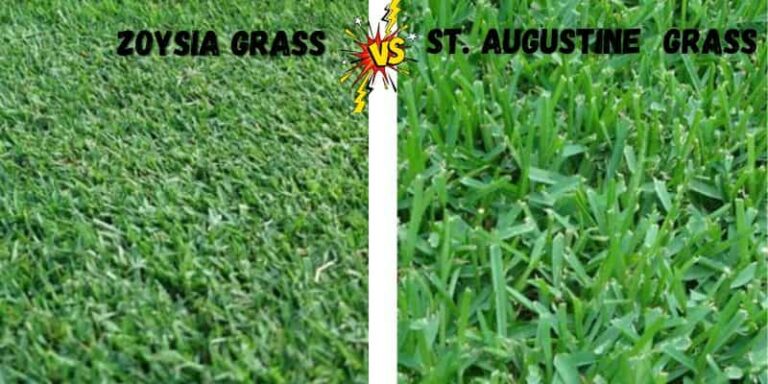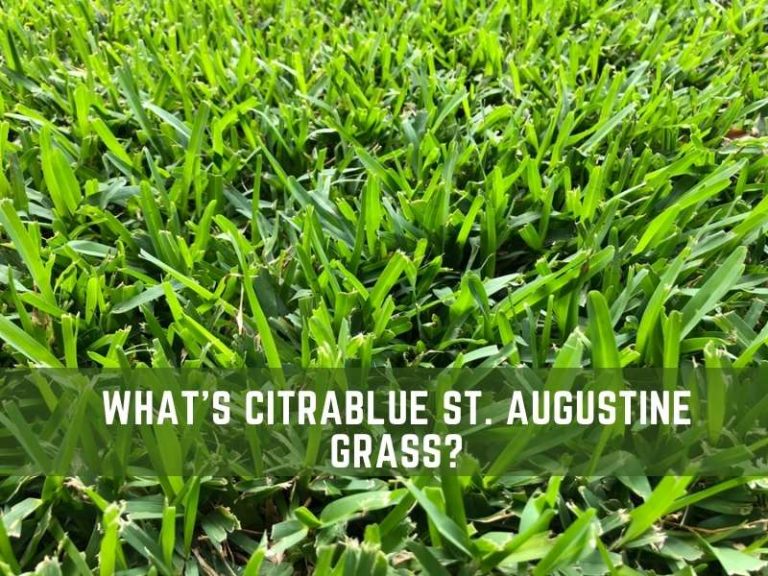How to Treat St. Augustine Grass Fungus + Identify Brown Patch
Fungal disease in St. Augustine grass typically begins to show as s 6-12 inch patches of discoloration that progress from yellow to brown. As the fungus spreads, the patches can merge to form larger areas of grass that are turning brown. So, how do you identify and get rid of the fungus in St. Augustine grass?
St. Augustine grass is prone to brown patch disease but other types of fungi can also infest it. Irregular brown patches and gray threads are a sign of fungus. Apply a lawn fungicide such as Scotts DiseaseEx early to treat the infection. Proper lawn care practices can also prevent lawn fungus.
Table of Contents
Signs of fungus in St. Augustine grass
The signs of fungal infections in St. Augustine grass may vary depending on the type of fungus. Some types of fungi affect the leaves more while others affect the roots. For example, brown patch affects primarily the leaf blades while Pythium ssp. causes root rot.
Here are the signs of fungus in St. Augustine grass:

Rotting leaves
Leaf rot is a major sign of brown patch disease in warm-season turfgrasses such as St. Augustine grass, Bermuda grass, and Zoysia. As the fungus spreads, it infects leaves that are at the base of the lawn.
The disease starts to show as rings and patches of yellow grass blades that eventually turn dark as they start to die and rot. You can easily tug and pull the leaves from the stems of St. Augustine grass. Yellow-brown rings of turf
Gray masses of fungal threads on turf
If you see small circular patches on your grass blades – measuring approximately 2-3 inches in diameter – you’re probably dealing with a fungus in your St. Augustine grass, specifically dollar spot disease. These quickly progress into irregular patches of brown or dead grass.
At a closer look, individual blades will have tan lesions on the margins. After a session of rain, you’ll spot whitish-to-gray masses of fungus in small patches on your lawn. These white masses can easily be confused with spider webs when looked at from afar.
Mushrooms in the lawn
The presence of mushrooms in your lawn is a sign of a type of fungus called fairy rings. The disease is categorized as fairy rings type I, II, and III with the first one not showing any mushrooms in the turfgrass.
This disease is common in summer and may indicate improper lawn top-dressing techniques or the presence of a large quantity of dead organic matter in your lawn. You might want to check for any tree stumps, logs, or such material buried beneath the turf.
Circular spots on grass blades
Small brown leaf spots appear as the initial signs of fungal disease on St. Augustine grass leaf blades. These circular spots quickly expand into elongated or oblong tan-colored spots on the foliage. The borders are usually purplish or brown, a major sign of gray leaf spots which at some point may manifest as patches of yellowing grass in your lawn.
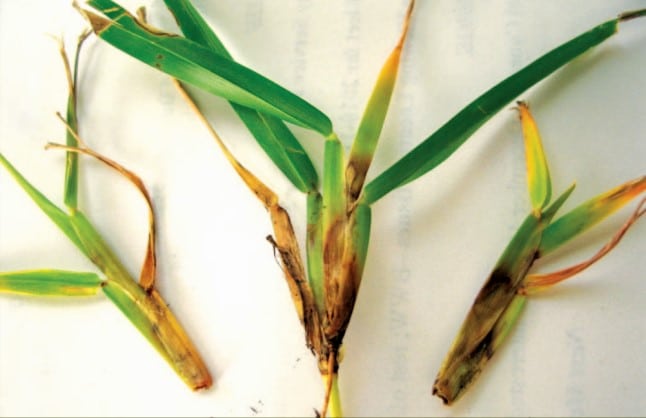
Thinning roots
For some other types of fungus in St. Augustine grass, there are no signs on the leaf blades or above-ground except for a thinning lawn, which can also be caused by many other factors including nutrient deficiency.
Upon the examination of roots, you’ll notice very few hairs on individual roots. The main roots will also appear thin to indicate a type of fungus called Pythium root rot is present. You might want to check your lawn for drainage issues since puddles of water in the lawn are a common cause of Pythium root rot in warm-season turfgrasses.
Rotting roots, stolons, and rhizomes
Rotting roots are not easy to identify, but if you see above-ground symptoms such as a thinning lawn, or irregular brown spots in your lawn, check the roots to see if they are healthy. Rotting roots with white and black lesions are a sign of take-all root rot fungal infection.
Stolons and rhizomes in creeping turfgrasses such as St. Augustine grass and Bermuda grass may also show signs of rotting. The grass becomes stunted and will develop bare patches rather quickly.
What causes brown patch disease?
Some types of fungi such as take-all root rot exist naturally in the lawn while others are triggered by the prevailing conditions in the grass. Therefore, it is important to determine the exact cause in order to prevent the disease from recurring after treatment.
Here are the causes of brown patch disease in lawns:
- Overwatering: Too much water from rainfall or irrigation leads to prolonged wetness in the lawn. Such conditions attract fungal diseases such as Pythium root rot in St. Augustine grass.
- Overfertilization: Applying too much fertilizer to your lawn can cause increased biological activity in your lawn, leading to fungal infections and even fertilizer burn. Keep in mind that Rhizoctonia fungus can also find nitrogen-deficient lawns more favorable.
- Shade in the lawn: Too much shade in your lawn can mean due to settles in the shaded areas for prolonged periods, which encourages fungi to grow.
- Hot and humid conditions: Rhizoctonia and pythium blight prefer hot and wet conditions. These fungal diseases advance rapidly when temperature conditions rise to about 80-90°F.
- Too much organic matter in the soil: Excessive organic matter can result from poor topdressing methods or leftover debris during lawn establishment. These attract fairy rings and mushrooms to germinate in the lawn.
During fall, Rhizoctonia fungi usually hide out in the grass thatch. The cold temperatures and high humidity during this time of the year favor them. As such, once the temperatures drop below 80°F, these fungi start penetrating the grass blades via the stomata, causing stress damage in the process.
How to Treat and Prevent St. Augustine Grass Fungus
The best way to control brown patch disease in St. Augustine grass lawns is by following a proper lawn care program that includes regular mowing, dethatching, core aeration, and a proper watering schedule. In case there are signs of the disease, early treatment using a fungicide is key in managing the damage. You may need to apply fungicides as a prevention measure in turfgrasses and regions that are prone to fungal infections.
Here are 7 ways to treat and prevent fungus in St. Augustine grass:
1. Apply a lawn fungicide
The most effective way to get rid of fungus in St. Augustine grass is by applying a lawn fungicide such as Scotts DiseaseEx or Cosan 20. Apply the treatment at the onset of the disease to treat and prevent brown patches in your lawn. Repeat treatments may be necessary if the disease is advanced.
Since the fungus in St. Augustine grass may be caused by different types of fungi, some fungicides may be more effective on some strains of the brown patch disease than others. Examples of effective fungicides include Azoxystrobin, Pyraclostrobin, and Fluoxastrobin.
Here are the best fungicides for brown patch disease in St. Augustine grass lawns:
| Fungicide | Target fungi |
| Scotts DiseaseEx (Azoxystrobin) | Brown patch, dollar spot, pythium blight, leaf spot, gray leaf spot, fairy ring, and take-all root rot. |
| BioAdvanced Fungus Control for Lawns (Propiconazole) | Brown patch, dollar spot, summer patch, anthracnose. |
| Monterey Consan 20 | anthracnose, leaf spot, downy mildew, gray mold, algae, black spots, rust, crown rot |
| Propiconazole Patch Pro | Dollar Spot, Anthracnose, Brown Patch, gray leaf spot, summer patch. |
| Cleary 3336F Fungicide (Thiophanate-methyl) | Brown patch |
You’ll want to avoid using any of these products exclusively in the long run, as gray leaf spot fungi usually grow resistant to them. A good idea would be to alternate them.
2. Improve soil drainage in your lawn
Fungi like to grow in wet conditions. Lawns that are poorly draining such as those established on clay soils may be susceptible to fungal infections. To prevent lawn fungus, core-aerate and dethatch your lawn regularly to encourage water to seep deep into the root zone.
You can also prevent standing water in your lawn by removing debris like rocks and sticks that may prevent or slow down water from draining into the soil.
3. Replace the affected sod
The best way to get rid of fairy ring fungus is to replace the affected lawn sections with new St. Augustine sod. This is a more eco-friendly option compared to the use of chemical fungicides.
Dig out the affected soil sections and refill them with a new St. Augustine grass sod. However, if you find this option to be too labor-intensive and time-consuming, you can opt for an appropriate fungicide such as flutolanil or Consan 20. For maximum efficiency, pick a fungicide product that combines at least two of these active ingredients.
4. Slightly lower the soil pH
Some types of fungi such as take-all root rot fungi thrive in highly alkaline soil conditions. You can treat and prevent this fungal disease in St. Augustine grass by gradually lowering your soil pH to be slightly acidic.
Apply ammonium sulfate to your lawn at a rate of 5.48 lb per 1000 sq. ft. every year to get rid take-all root rot fungus in your lawn. You can mix it with peat moss for better control of this fungus.
This treatment is gradual and more of a preventative measure. You can get rid of take-all root rot faster by using appropriate fungicides, which include myclobutanil and propiconazole. For St. Augustine lawns, these fungicides are best applied during spring and fall. Water your lawn after the application of these fungicides to ensure the active ingredient penetrates into the root zone and the soil to kill the fungi.
5. Avoid overwatering your lawn
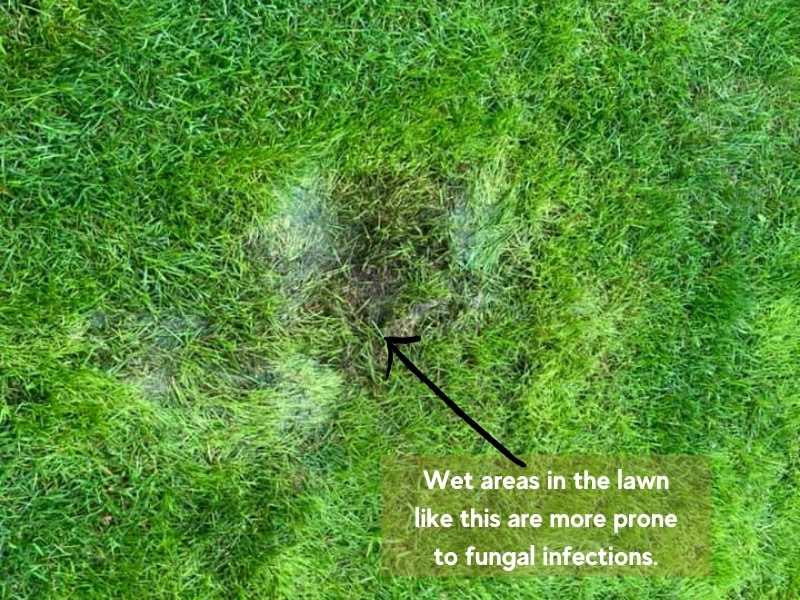
St. Augustine requires about 0.5 inches of water per week to grow fast and thick. Overwatering encourages fungal activity as it keeps the lawn wet for prolonged periods. If this is what’s causing brown patch disease in your lawn, adjust your watering schedule and check the amount of water you’re providing.
- Water your lawn twice a week, each time providing it with about ¼-inch of water.
- Place a measuring cylinder in your lawn then run the sprinkler until the ¼-inch mark is reached every time you irrigate the lawn to prevent overwatering.
6. Reduce shade in your lawn
Shade allows for dew to last longer on your lawn, which encourages fungal growth. Instances of gray leaf spot and dollar spot in St. Augustine grass are common in shaded lawns.
Cut any canopy above St. Augustine grass to allow it to receive at least 7 hours of direct sunlight to prevent lawn fungus.
7. Water your lawn at sunrise
Watering your lawn too early in the morning exposes the grass to prolonged periods of wetness, which encourages the growth of fungus. It is best to water your St. Augustine grass lawn from mid-morning when the sun has already risen.
Watering at sunrise allows your lawn to dry up quickly and prevents fungal spores from germinating and causing brown patch disease.
Types of Fungus in St. Augustine Grass (Identification)
St. Augustine grass fungus disease is generally referred to as brown patch disease, but that’s just one type of fungal disease that affects most warm-season turfgrasses. Most lawn fungal infections eventually manifest as visible patches of brown discoloration in lawns, hence the name.
Here are the different types of fungus that can affect St. Augustine grass:
Brown patch disease (Rhizoctonia solani)
Brown patch or Rhizoctonia solani species is the most common type of fungus in warm-season turfgrasses such as St. Augustine grass and Zoysia. The fungus normally attacks the base of the grass blades close to where the plants meet the soil. As a result, the base of the leaf blades rot and have a distinctive dark shade. You can also sense a decaying smell if you pull out the affected blades and hold them close.
You’ll also notice that the affected leaf blades tend to pull away from the plant without much resistance. The roots, however, usually won’t show any signs of damage.
After a while, the problem spreads from the base of the grass blades to the rest of the blades, resulting in reddish-brown patches as the leaves die. With time, these brown patches can extend for up to several feet in diameter, leaving you with an unsightly lawn.
Rhizoctonia may inhabit the soil for a while before causing visible damage to your St. Augustine turfgrass. The fungus can stay inactive in the lawn thatch until conditions become favorable.
Dollar spot disease (Sclerotinia homoeocarpa)
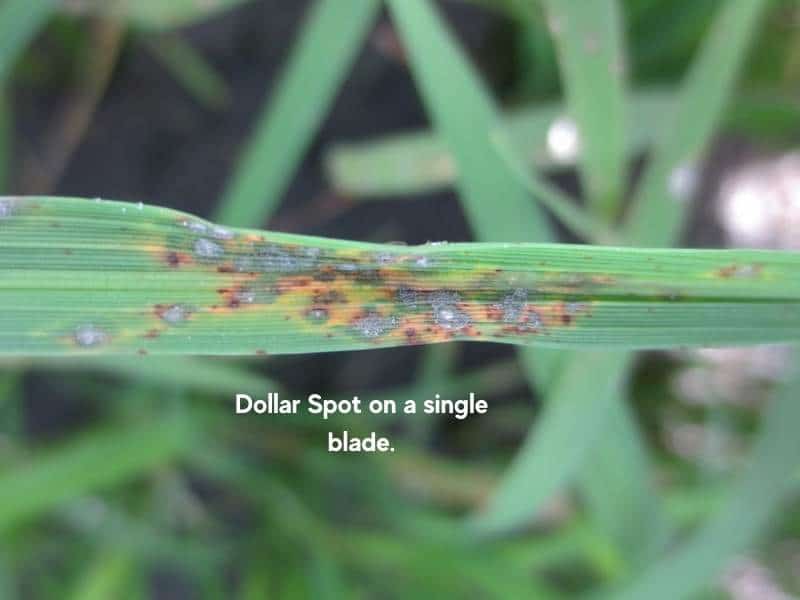
Dollar spot is a lawn fungal disease that’s characterized by random, circular patches that are about 3 inches in diameter. You may also notice tan-colored lesions on the edges of individual grass leaf blades, each surrounded by brown or purple rings. The fungi that cause this disease also produce fungal threads that are grayish-white and fluffy in texture.
Gray leaf spot (Pyricularia grisea)
During the early stages of invasion, you can tell that gray leaf spot fungi are present on your St. Augustine turf if you notice that some of the individual grass leaf blades are spotting tiny, brown spots. After a while, these spots usually enlarge into circular, tan-colored spots with brown margins. In highly humid conditions, you’re likely to notice the spots turning gray, as the fungi produce spores at the center.
Since gray leaf spot fungi attack sections of individual leaf blades, it’s not immediately noticeable as there are no dead giveaways in the form of large brown patches. However, you may notice that the turf is thinning out, much in the same way as it would when undergoing drought stress.
Fairy rings (Basidiomycetes)
Basidiomycetes are the family of soil fungi that cause fairy ring disease in St. Augustine grass. They trigger turf damage by depleting nutrients in the soil and releasing a toxic by-product that harms the turfgrass upon contact.
Fairy rings on St. Augustine lawns are characterized by zones of dead, brown grass surrounded by dark-green zones. You may also identify this disease if there are mushroom mycelia growing in rings in close proximity to these dead spots.
Pythium blight (Pythium spp)
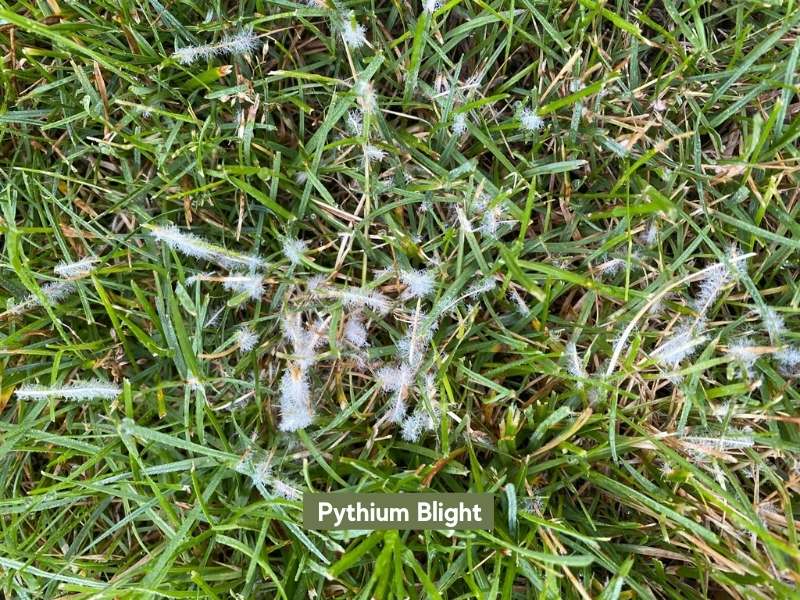
Pythium fungus is known to cause Pythium blight which is also called grease spot disease. The spores of this fungus are usually transported across the lawn as runoff water drains through the St. Augustine lawn.
During the early stages of this fungal disease, sections of your St. Augustine turf will assume a gray tan and a wilted appearance. As the fungi advance, you’ll begin noticing brown and matted spots on your turf, which may be surrounded by bronze-colored grass blades on the edges.
Take-all root rot disease (Gaeumannomyces graminis)
The earliest sign of take-all root rot is when sections of your turf turn light green- yellowish, instead of the dark green hue that you’ve become accustomed to. After a while, if you pull off the stolons and roots of individual grass blades in the affected areas, you’ll notice black-colored lesions and root rot. The decaying of the roots causes the affected grass plants to die, leaving behind bare spots on the lawn.
This soil-inhabiting fungus also loves to make a habitat out of St. Augustine stolons and lawn thatch that lies between the topsoil and the base of the grass blades.
Pro tip: Brown patches in your lawn can also be caused by other diseases, grubs, and even chinch bugs in St. Augustine grass. A closer investigation may be necessary to determine if it is really fungus or something else before applying the right treatment.
Here is a video Pythium Root Rot
Can the grass recover from fungus?
After you’ve completely rid your St. Augustine turf of disease-causing fungi, the visible signs of damage will still be present on the turf. Luckily, you can help your turf recover to its lush green, healthy appearance by doing the following:
- Adopting proper irrigation practices- avoid watering your St. Augustine lawn at night and instead do so in the morning. Daytime watering is less attractive to the growth and reproduction of fungi.
- Mowing at the proper height- a well-maintained lawn that’s mowed at the appropriate height will have enough natural defenses to keep off fungal damage. A good height for mowing St. Augustine grass is between 3-4 inches.
- Aerating and overseeding- core aeration prior to overseeding during early fall is recommended to help your turf recover from summer stress and stay healthy enough to keep off fungal diseases.
How long does fungicide spray last?
Fungicide application on turfgrass provides 7-21 days of protective effects depending on the specific product, disease, and environmental conditions.
Most fungal lawn diseases run their course and will improve within 2-6 weeks after appropriate fungicide treatment. Severe fungal infections may take longer recovery periods. Adjusting turf care practices and re-application may be necessary to maintain control and prevent re-infestation. Monitoring conditions and understanding the signs of fungal lawn disease are important to determine optimal retreatment timing.
References
- Alicia Lamborn, Environmental Horticulture Agent, University of Florida IFAS Extension: Turfgrass Disease Identification Key
- Young-ki Jo, Assistant Professor and Extension Plant Pathology Specialist, The Texas A&M System: Take All Root Rot
- Cheryl Smith, Plant Health State Specialist Emeritus, University Of New Hampshire Extension: Rhizoctonia Brown Patch [Fact Sheet]

